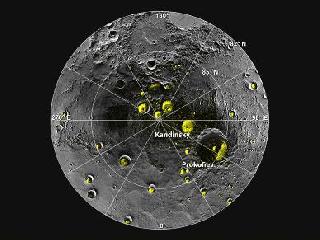
Tradar image of Mercury's north polar region is shown superposed on a mosaic of MESSENGER images of the same area. All of the larger polar deposits are located on the floors or walls of impact craters. Deposits farther from the pole are seen to be concentrated on the north-facing sides of craters. Photo: NASA/Johns Hopkins University Applied Physics Laboratory/Carnegie Institution of Washington/National Astronomy and Ionosphere Center, Arecibo Observatory.
WASHINGTON (PTI): A NASA spacecraft has confirmed the presence of abundant 'icy' water along with other frozen volatile materials within 'burning hot' Mercury's permanently shadowed polar craters.
NASA's MErcury Surface, Space ENvironment, GEochemistry, and Ranging (MESSENGER) spacecraft has been studying Mercury, the nearest planet to the Sun, in unprecedented detail since its historic arrival there in March 2011.
Scientists have seen clearly for the first time a chapter in the story of how the inner planets, including Earth, acquired their water and some of the chemical building blocks for life, NASA said in a statement.
"The new data indicate the water ice in Mercury's polar regions, if spread over an area the size of Washington, DC, would be more than 2 miles thick," said David Lawrence, a MESSENGER participating scientist at the Johns Hopkins University Applied Physics Laboratory (APL).
Spacecraft instruments completed the first measurements of excess hydrogen at Mercury's north pole, its reflectivity of polar deposits at near-infrared wavelengths and enabled the detailed models of the surface and near-surface temperatures of the planet's north polar regions.
Given its proximity to the Sun, Mercury would seem to be an unlikely place to find ice. However, the tilt of Mercury's rotational axis is less than 1 degree, and as a result, there are pockets at the planet's poles that never see sunlight.
Scientists suggested decades ago there might be water ice and other frozen volatiles trapped at Mercury's poles.
Images from the spacecraft taken in 2011 and earlier this year confirmed all radar-bright features at Mercury's north and south poles lie within shadowed regions on the planet's surface.
The new observations from MESSENGER support the idea that ice is the major constituent of Mercury's north polar deposits. These measurements also reveal ice is exposed at the surface in the coldest of those deposits, but buried beneath unusually dark material across most of the deposits.
In the areas where ice is buried, temperatures at the surface are slightly too warm for ice to be stable.
MESSENGER's neutron spectrometer provides a measure of average hydrogen concentrations within Mercury's radar-bright regions.
"We estimate from our neutron measurements the water ice lies beneath a layer that has much less hydrogen. The surface layer is between 10 and 20 centimetres [4-8 inches] thick," Lawrence said.
 Previous Article
Previous Article Next Article
Next Article













The Indian Air Force, in its flight trials evaluation report submitted before the Defence Ministry l..
view articleAn insight into the Medium Multi-Role Combat Aircraft competition...
view articleSky enthusiasts can now spot the International Space Station (ISS) commanded by Indian-American astr..
view article